Key takeaways:
- Building an author platform is essential for visibility and credibility; it involves genuine engagement with readers beyond just sharing books.
- Identifying a target audience through demographics, interests, and reading habits allows for tailored messaging and deeper connections.
- Creating diverse and engaging content, including personal stories and interactive formats, enhances reader interaction and community building.
- Collaborating with other authors expands reach, while tracking growth through analytics helps refine strategies and celebrate milestones.
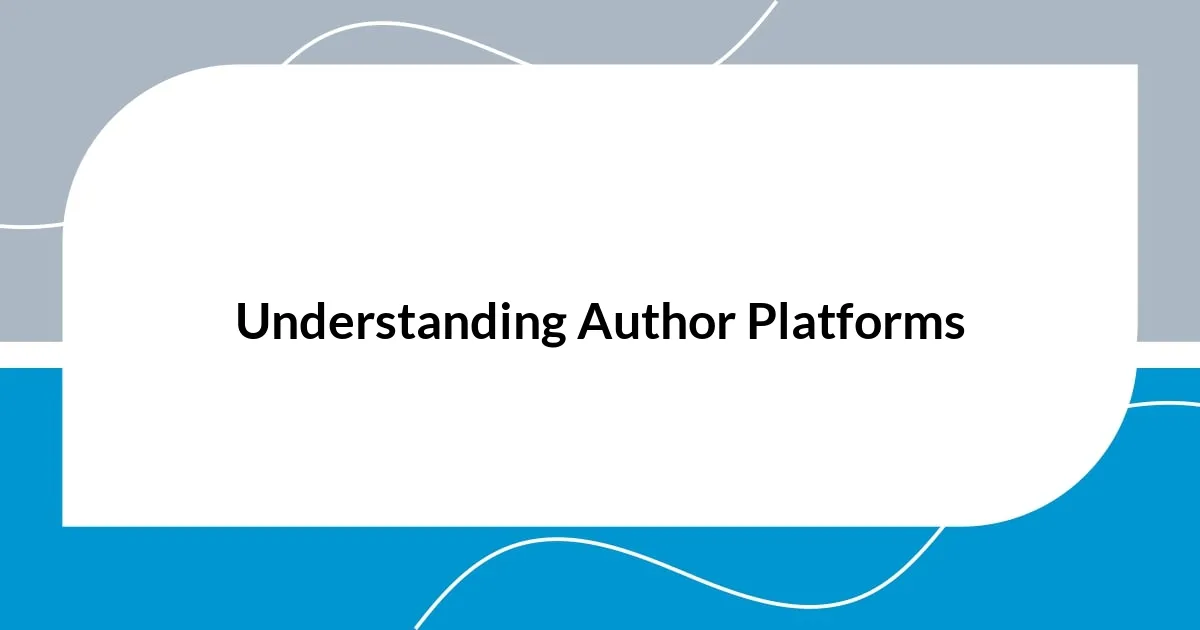
Understanding Author Platforms
An author platform isn’t just a fancy term; it’s the foundation of your visibility and credibility as a writer. I remember when I first started sharing my thoughts online—it felt like shouting into a void. But as I began to cultivate connections with my audience, I realized these interactions were key to establishing trust and community.
When I think about my own journey, I can’t help but wonder—how many potential readers have I missed by not actively engaging with them? Building an author platform requires more than just sharing your book; it’s about creating a genuine dialogue. Sharing personal stories and insights allows readers to feel connected to the person behind the pages, making them more invested in your work.
Many often underestimate the need for an author platform, believing that great writing alone will suffice. However, I’ve found that having a robust online presence not only showcases my work but also opens up opportunities for collaboration and feedback. It’s incredible how these connections can lead to unexpected growth, both personally and professionally.
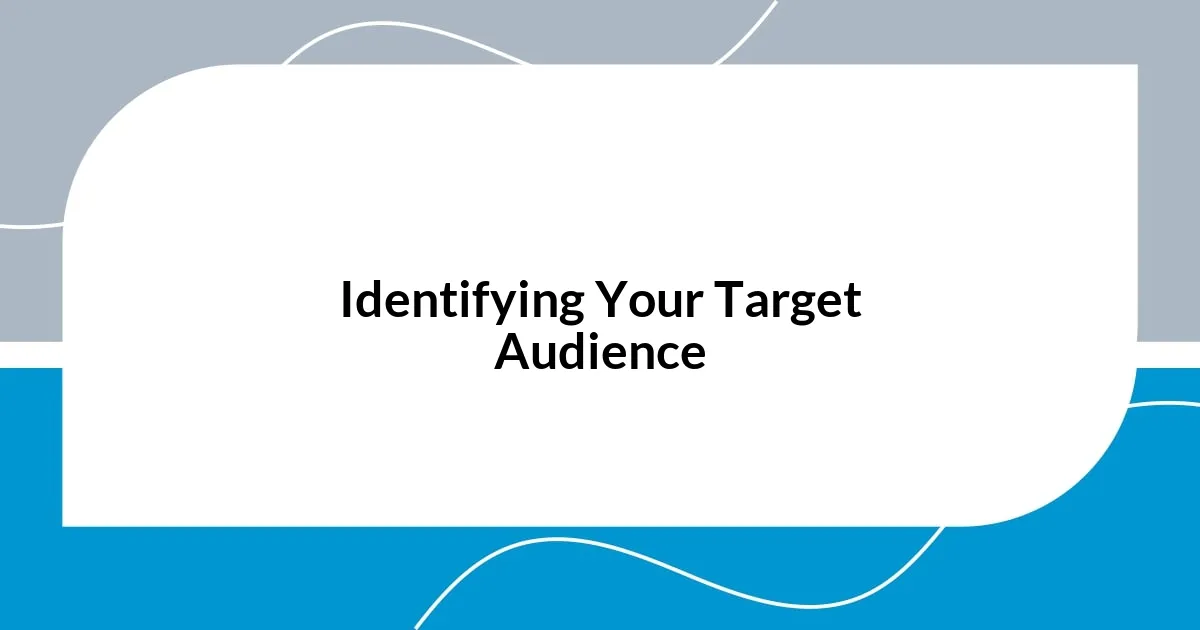
Identifying Your Target Audience
Understanding your target audience is a crucial step in building an effective author platform. When I launched my first book, I initially thought everyone would be interested in my stories. However, through trial and error, I discovered that defining a specific audience significantly sharpened my focus. I began to tailor my messaging to those who resonated with my themes, and that made all the difference.
To identify your target audience, consider the following points:
- Demographics: Age, gender, location, and education can inform your writing style and marketing approach.
- Interests: What hobbies or passions do they have? This helps you connect with them on a personal level.
- Reading Habits: Understanding what genres they prefer can shape your content and promotion strategies.
- Challenges: Knowing their pain points allows you to address their needs directly in your writing.
- Social Media Usage: Where do they gather online? This can guide where you focus your efforts.
By genuinely engaging with these specifics, I felt a renewed sense of purpose in my writing. I remember receiving heartfelt messages from readers who felt seen and understood through my stories—those moments affirmed that I was indeed connecting with the right people. This process not only enhances your writing but also fosters a community of passionate supporters.
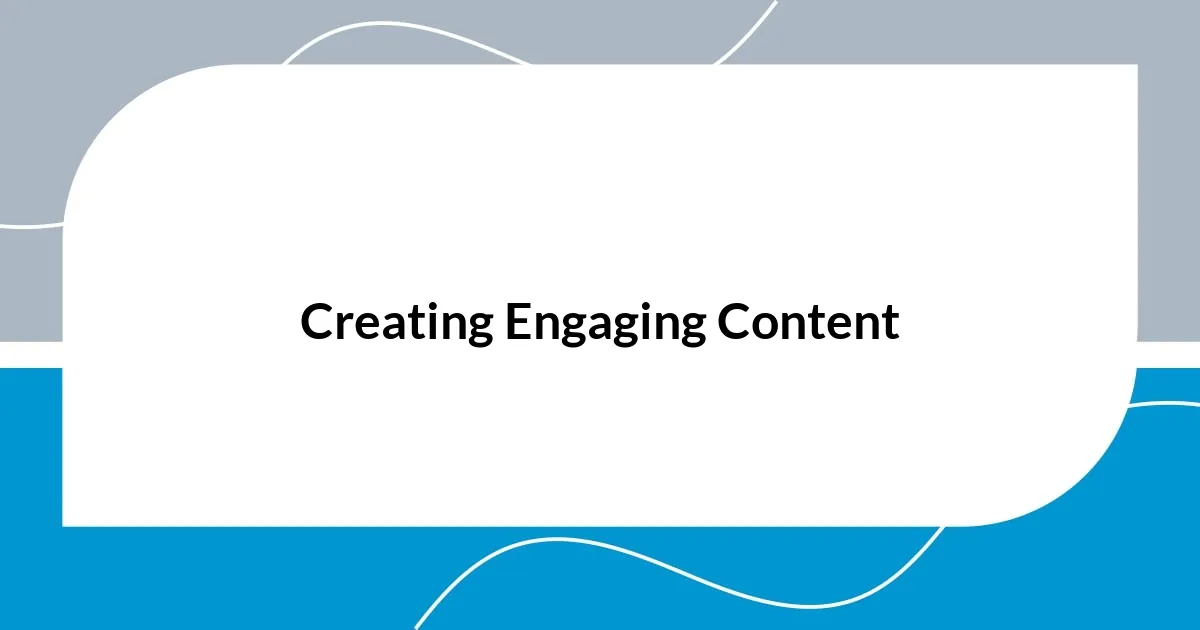
Creating Engaging Content
Creating engaging content involves tapping into what genuinely resonates with your readers. I recall a time when I decided to write a blog post that delved deep into my writing struggles. To my surprise, it struck a chord with many, prompting readers to share their experiences. This openness fostered a stronger bond and showed me that vulnerability can be a powerful tool in content creation.
I’ve also learned that variety is essential. Different formats, like podcasts or videos, can capture diverse audiences. For instance, I created a series of short videos discussing character development. The engagement from viewers was surprising! They not only resonated with the content but also started sharing their character-building challenges, creating an interactive community. Isn’t it amazing how varied content can enhance engagement?
While consistency is crucial, I find that spontaneity keeps things fresh. I once posted an impromptu Q&A on social media after receiving a wave of curious messages. It sparked lively discussions and reminded me that my audience craved interaction. Incorporating real-time engagement like this can significantly boost your connection with followers, making them feel valued and heard.
| Content Type | Engagement Level |
|---|---|
| Blog Posts | Moderate |
| Videos | High |
| Podcasts | High |
| Social Media Q&As | Very High |
| Newsletters | Moderate |
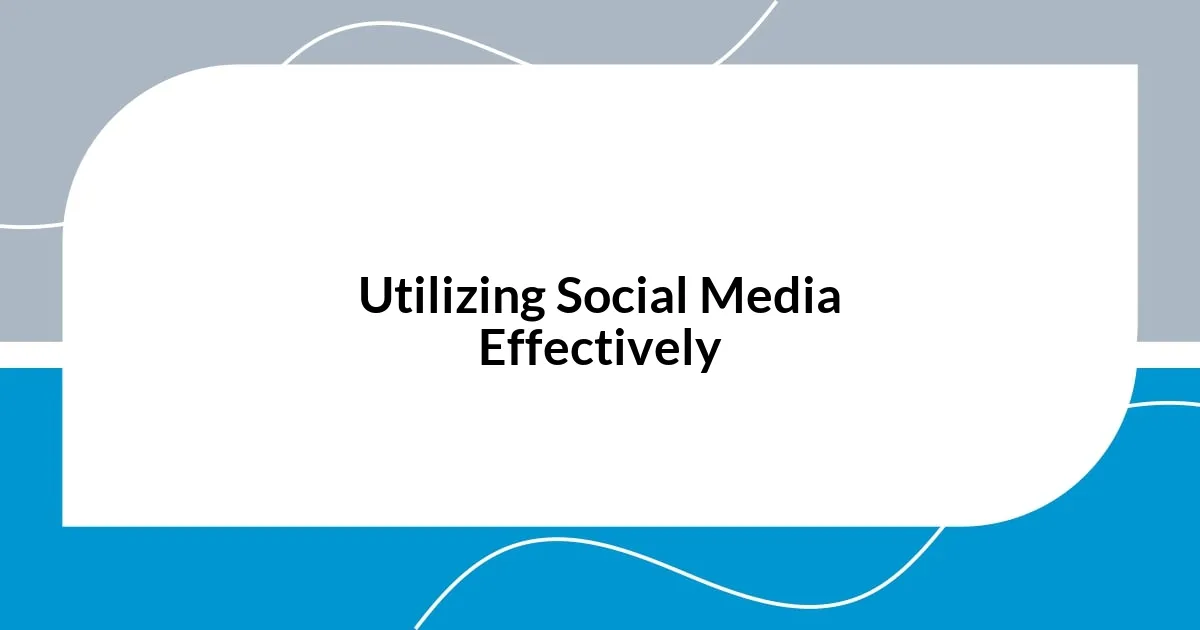
Utilizing Social Media Effectively
Utilizing social media effectively requires a strategic approach that aligns with your target audience’s preferences. I remember when I first started posting on platforms like Instagram and Twitter, I felt overwhelmed by the sheer volume of content. But then I focused on quality over quantity. Crafting thoughtful posts that prompted discussion led to unexpected connections and meaningful conversations—not just likes. Have you ever noticed how one genuine interaction can spark a series of engaging exchanges? That’s the power of truly engaging with your audience.
I found a sweet spot on social media when I began sharing behind-the-scenes glimpses of my writing process. The posts where I showcased my messy desk or shared my favorite coffee blend during writing sessions resonated deeply with my followers. It humanized me, making readers feel a part of my journey. This experience made me realize that vulnerability can build strong relationships online. When was the last time you shared a personal insight? Trust me, it can transform your online presence.
Frequency is important, but so is knowing when to pause. I once scheduled a week-long break from social media. While it was initially terrifying, I returned to find my audience eager for more. They had contacted me, wondering where I had gone! This taught me the value of creating anticipation. How often do we take a step back to let our audience miss us? Balancing your online presence with moments of absence can create an exciting dynamic that keeps readers engaged.
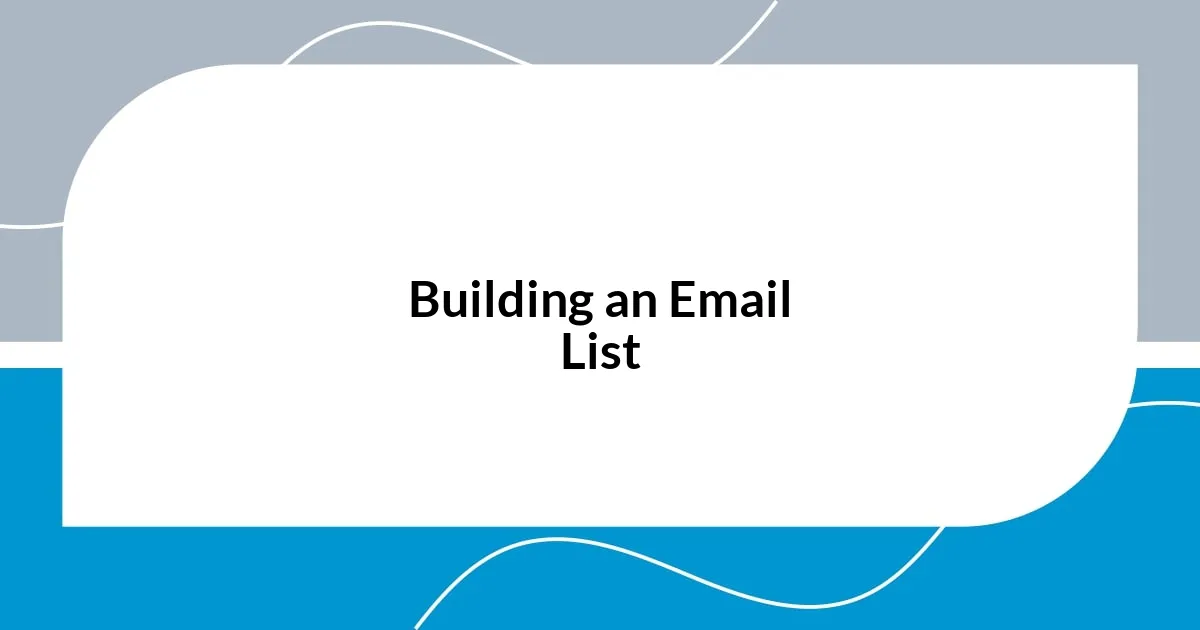
Building an Email List
Building an email list is one of the most valuable assets I’ve cultivated in my author journey. Initially, I was hesitant to ask people for their email addresses, fearing I might come off as too pushy. However, when I launched my first newsletter, I was amazed at the response! I crafted it like a letter to a friend—sharing not just updates, but little anecdotes from my writing life. This personal touch created a cozy atmosphere, making my readers feel included in my journey.
One approach that genuinely resonated with my audience was offering a freebie. I created a downloadable guide on writing tips based on my experiences. To my surprise, many subscribers mentioned that it was exactly what they needed to kickstart their own writing projects. This interaction made me realize that providing value upfront fosters trust. Have you ever thought about what unique insights you can offer to your readers? Remember, it doesn’t have to be elaborate—it just needs to be authentic.
As my list grew, I made it a point to segment my subscribers based on their interests. This simple step allowed me to tailor content specifically for them, making my emails more relevant. I still distinctly recall the day someone responded to my newsletter sharing how a particular story idea inspired them. Moments like this not only reaffirmed the power of a targeted email list but also strengthened the bond between us. It got me thinking—how well do you know the preferences of your own readers? Striving for that connection transforms a list of emails into a community.
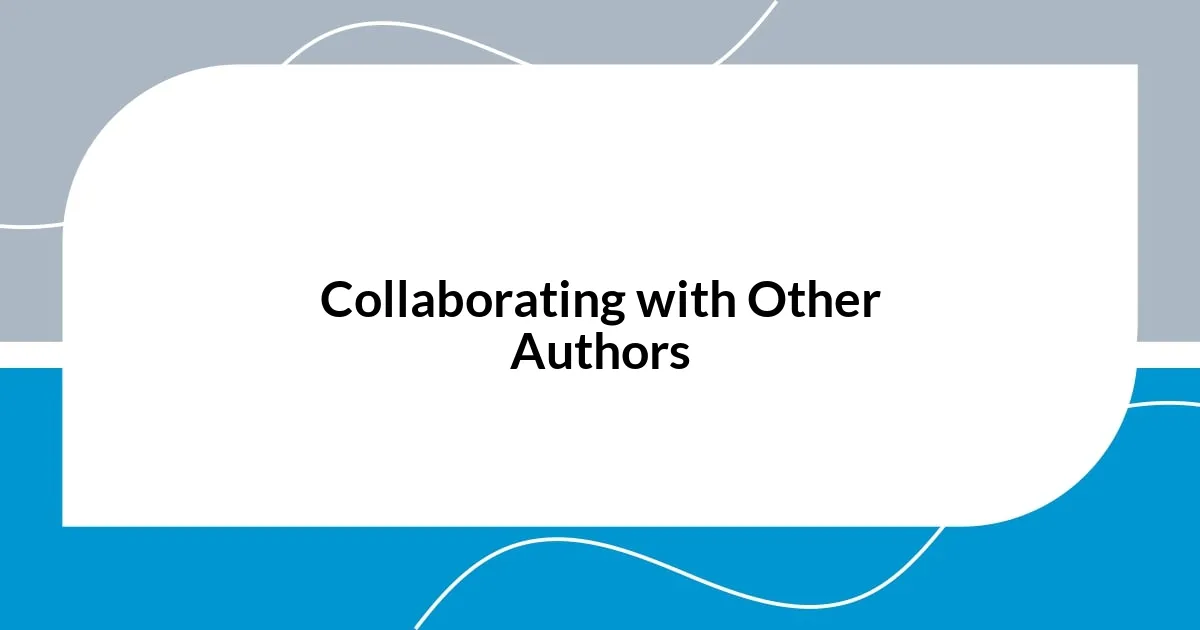
Collaborating with Other Authors
Collaborating with other authors can significantly enhance your visibility and credibility in the literary world. I remember a time I teamed up with a group of indie authors for a joint book launch. We pooled our resources, shared our audiences, and promoted each other’s work across our platforms. The result? A buzz that none of us could have created individually! Have you thought about how powerful that collective energy can be?
One of my favorite collaborations involved hosting a virtual panel discussion with fellow writers. We chose a theme that resonated with all our audiences and invited readers to join us live. The engagement during the Q&A segment was electric! It was a gratifying experience to receive real-time feedback and connect with readers I’ve never met before. Have you ever experienced that kind of lively interaction? I strongly believe it builds a sense of community that’s irreplaceable.
Additionally, participating in anthologies or joint projects can introduce your work to a whole new set of readers. I’ve contributed to several themed anthologies, and each time, I saw an uptick in my follower count and newsletter sign-ups. It’s exhilarating to realize that you’re not just sharing your voice, but also uplifting others in the process. How could you leverage collaboration to enrich your author journey? Embracing the power of teamwork might just open doors you never knew existed.
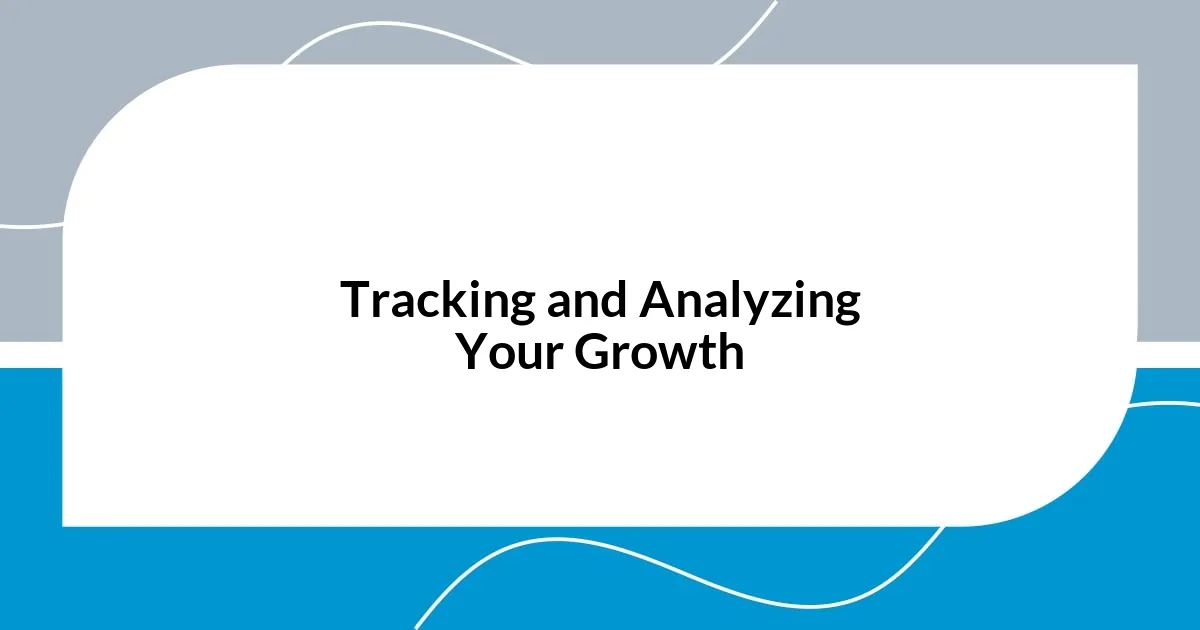
Tracking and Analyzing Your Growth
Tracking my growth as an author has been a game changer for me. Initially, I simply checked my follower counts and email subscribers, but I soon realized there’s so much more to it. I began using analytics tools to assess engagement rates on my social media posts and the open rates on my emails. For instance, when a particular post about my writing process saw an unexpected spike in engagement, it made me reflect on what really connects with my readers. What if this kind of data could help guide my future content?
The act of recording my growth has also influenced how I set my goals. I remember the first time I plotted my subscriber growth on a chart and watched it rise after launching an interactive poll. That thrill of seeing direct feedback from readers was exhilarating! It not only motivated me to keep engaging with my audience but also helped me fine-tune my strategy based on what they genuinely wanted to hear. Isn’t it fascinating how our readers can shape our writing journey when we pay attention?
Moreover, I’ve found that consistency in tracking helps me celebrate small wins along the way. For example, I keep a journal where I note down insights and improvements. Recently, I celebrated reaching my first 100 engaged commenters on a blog post. Sharing that milestone on my social media wasn’t just about numbers; it was a heartfelt moment to connect with those who have supported me. Have you thought about how recognizing these milestones can empower your own journey? Each step provides a fresh perspective and encourages us to keep building our platforms with intention.